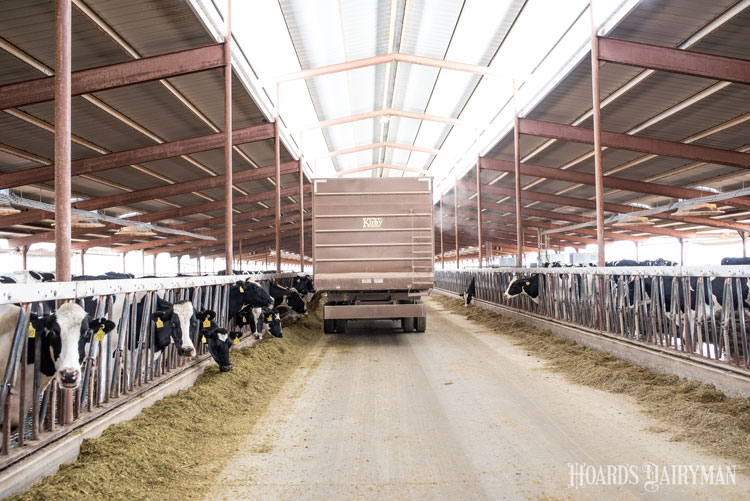“We know that feed costs are one of the highest costs for dairies today, if not the highest,” began Betsy Hicks during a Cornell Cooperative Extension webinar. That’s why it is so critical to avoid delivering excess nutrients to our dairy animals that they don’t or can’t utilize.
This practice of providing the right amount of nutrients is described as precision feed management, explained the extension dairy management specialist. That term also includes deriving most of those nutrients from homegrown feeds with good forage and feeding management since the largest source of imported nutrients is purchased grains, a large expense that can also lead to environmental concerns when overfed.
Achieving precision feed management is a continuous process of improvement to boost nutrient efficiency, optimize homegrown feed, and maximize income over feed cost (IOFC), Hicks said. She provided a few benchmarks to monitor along the precision feeding journey:
Metric | Goal |
Neutral detergent fiber (NDF) intake as a percentage of body weight | > 0.9% |
Forage as a percentage of the diet | > 60% |
Homegrown feeds as a percentage of the diet | > 60% |
Ration phosphorus as a percentage of requirement | < 105% |
Diet crude protein (CP) | < 16.5% |
Milk urea nitrogen (MUN) | 8 to 12 |
Calving interval | < 13 months |
Cows dead or culled before 60 days in milk | < 5% |
Precision feeding involves every aspect of the farm, Hicks noted. The last two items in the above table focus on keeping the herd that you are feeding efficient.
Dietary and nondietary tools
To make progress toward those benchmarks, Hicks described that there are dietary and nondietary factors that affect how precise a farm can feed its cows. The dietary side begins with understanding how feed mixing and delivery are affecting cow intake so we can formulate a ration that is truly going to give cows what they need, she said.
To know what a cow needs, we need to understand the cow. This includes milk production and components but also covers body weight and body condition score, which many farms may not track. “If we can’t identify this cow including body weight and body condition, we’re going to have a very hard time getting her what she needs,” Hicks emphasized.
With that information, grouping cows by nutritional needs can be a good option when it’s possible. Research from Cornell showed that grouping cows nutritionally can result in a $31 higher IOFC per cow per year, she noted. Needs may vary between stages of lactation, young versus mature cows, and even far-off and close-up dry cows.
Then, when making your rations, pay attention to what you’re feeding and adjust as necessary. Take regular forage samples, which may be monthly if you are milking 50 cows or every week if you are closer to 1,000 cows. Not sampling enough leaves money on the table, Hicks stressed. Reformulating diets more frequently improves dry matter intake, energy balance, and milk yield.
Factors unrelated to the diet affect how the cow consumes its feed. Social grouping, stocking density, water availability, and time away from the pen all impact how well “a cow can be a cow and utilize the nutrients we’re providing,” said Hicks. She advised having cows away from the pen no more than 3.7 hours a day.
Grouping cows by social needs can overlap with grouping by nutritional needs, particularly for first lactation animals that are still growing and will eat more when they’re not in competition with older cows. “It makes sense to group first-lactation cows by themselves,” Hicks noted.
Cows in overcrowded pens will prioritize lying space over feeding, she added. They will wait for a stall to open up instead of eating. Crowded pens can also encourage dominance behavior, and Hicks cited that when feed is limited, dominant cows will eat 14% to 23% more feed than submissive cows. This doesn’t allow farm managers to get nutrients to the herd efficiently.
Hicks summarized that feeding precisely is not a one practice approach or one time effort. It involves watching benchmarks, setting cropping goals, making adjustments, and providing a desirable environment for the cow. It pays off in making the most out of every dollar paid or invested in feed.
To comment, email your remarks to intel@hoards.com.(c) Hoard's Dairyman Intel 2024 January 15, 2024









